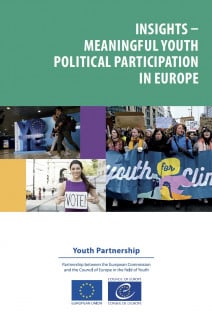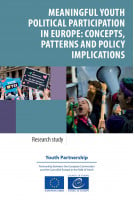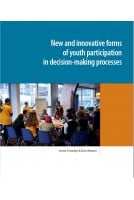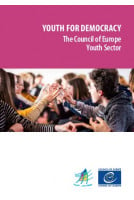Supporting policy makers and practitioners to facilitate, support and promote meaningful political participation of young people
Young people’s political participation has many diverse forms; it can be conventional or unconventional, and include activities such as voting, being a member of a political party, serving on a local youth council, engaging through a youth organisation or taking part in online political activism, boycotts or a protest movement. This edition of Insights “Meaningful youth political participation in Europe” examines the key concepts and aims of youth political participation, types of democratic environments and various mechanisms of participation within the context of shrinking space for civil society, rapid digitalisation, advancement of populist ideologies, increased inequalities, a rise of global youth movements and a health pandemic.
Both conventional and unconventional types of participation are explored throughout the publication, reflecting upon young people’s participation skillsets, the cultural sensitivity of participatory opportunities and intersectionality. The authors conclude with a set of recommendations for the youth sector to support the development of a more open, transparent and accessible democratic environment for young people.
FIGURES TABLES ABBREVIATIONS INTRODUCTION KEY CONCEPTS OF MEANINGFUL YOUTH POLITICAL PARTICIPATION
1. Political participation
2. Aims of youth political participation
3. Types of democratic environments
4. Reconstructing meaningful youth political participation
CONVENTIONAL YOUTH POLITICAL PARTICIPATION, TRANSFORMATIVE EXPERIENCES AND CULTURES OF PARTICIPATION
1. Development of civic skills and participatory democracy
2. Conventional youth participation practices
3. Case study: youth councils
4. Case study: participatory budgeting
5. Youth as active citizens
UNCONVENTIONAL YOUTH POLITICAL PARTICIPATION, SOCIAL MOVEMENTS AND YOUTH ACTIVISM
1. Unconventional youth political participation
2. Youth activism in social movements and do-it-ourselves politics
3. Sociopolitical contexts, conditions and resources of unconventional youth political participation
4. Intersectionality and patterns of exclusion
5. Case study: the climate justice movement
6. Youth political participation in times of crisis
RECOMMENDATIONS FOR POLICY MAKERS, PRACTITIONERS AND RESEARCHERS
Recommendations for the youth sector
REFERENCES








